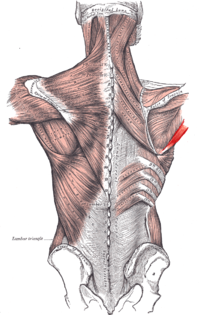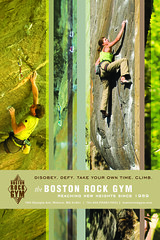
THATS MY "SOMETHING"
It’s been about 5 weeks since I tore “something” in my back at Rumney on a damn-near-send of my project DR. NO (5.13d). This stupid route is so withing reach for me yet somehow unclimbable that it has kept me up night envisioning the crux move in my head. As it turns out, the “something” in my back appears to be my Teres Major. A muscle primarily responsible for bringing the arm downward and back. Which, as it turns out is really important for any sort of rock climbing. So for the last five weeks I have gone in a steady rotation of “feeling better”, climbing, “feeling like hell”, not climbing, trying to train, realizing that I can’t, and then the final stage is always frustration. I’d imagine that most climbers can relate to this. The worst part is waking up every morning and seeing a crisp blue sky peeking through my window taunting me. I know there are amazing climbing conditions awaiting me at all my favorite spots. Not to mention the unfinished business I have at various climbing areas in the region.

The Author on his bajillionth attempt at Dr. No at Rumney.
Indeed it seems as though we hurt ourselves when the timing is worst. Although, I suppose it is worth mentioning that there is never exactly a “good” time to be injured. Yet there is hope. In the past couple of weeks, I have designed a regimen of exercises that have allowed me to train, feel at least somewhat useful, and not agitate my injury. In fact, this routine has shown such good results in my finger strength and overall fitness levels that I am going to incorporate it in to my regular routine once my Teres Major stops harassing me any time I try to doing any kind of pulling. These workouts take around 1 hour in the climbing gym, which is very low committment. I would like to share this with you, encourage you to try it, and see what happens:
- DAY ONE: RESISTANCE AND ENDURANCE–These exercises should be done with a light-ish weight that will allow you to do between 8-12 reps on each set, with rests of 30 seconds or less between sets, and 1 minute or less between exercises. Keep your heart rate elevated, work up a sweat.
-3 sets of push ups in to leap-frogs: Do a standard push up, with arms bent at 90 degrees when you are at the bottom of the motion, then once finishing the motion, do a leap-frog. A leap-frog is where you jump straight up and swing extend your hands high above your head. In the air the body has to be straightened from the fingers to the toes. Leap-frogs should go as high as possible. When you land, drop back into push up position and repeat.
-3 sets of Incline bench crunches: Do simple crunches on an incline with your hands resting across your chest. Make sure to be pulling with your abs by tilting your pelvis forward and not arching your back. Exhale as you crunch to tighten your abdomen even more.
-3 sets of weighted lunges: Choose dumbbells of an appropriate weight, and stand straight with them at your side. Step forward with either leg while bending at the knee until the front thigh is approaching parallel to the ground, and the rear leg is bent at the knee and balanced on the toes. Don’t let the forward knee go past the tip of the toes. This can aggravate the knee-joint if done too much. Step back into standing position and repeat the motion with the other leg, alternating legs until the exercise program set is complete.
-3 sets of hanging leglifts: Hanging from the jugs on the Metolius Hangboard, engage your upper body and your abs. Then lift both legs up so your feet are out in front of you. Keep your legs straight if you can holding briefly here, and then lower your legs back to the starting position. Move in a slow and controlled manner when lifting and lowering, so you’re using your muscles and not gravity or momentum.
-4 sets of leap frogs: See above, minus the pushups.
- DAY TWO: FINGER STRENGTH-All of these exercises are done without pulling. Essentially all deadhangs which are necessary for my current injury. (Use whatever holds on campus rungs or hangboard you can hang from for at least 12 seconds.)
-3 sets of deadhangs on small campus rungs: Make sure to do these with your fingers closed in a crimp position. Hold as long as possible.
-3 sets of deadhangs on 45 degree slopers on the Metolius Hangboard.
-3 sets of deadhangs on shallow 2 finger pockets on Metolius Hangboard.
-3 sets of “finger pullups” on large edges of Metolius Hangboard. (arms straights, crimp and release crimp in a slight curling motion with fingers, like doing a pullup using only your fingers.)
- DAY THREE: POWER CROSS TRAINING-These are power motions that I think provide both solid foundational strength as well as fitness applicable to climbing.
–3 sets of kettle bell snatches:Click here to see a really in-articulate gentleman explain how to do a kettlebell snatch. This is an amazing full body exercise. Highly recommended.
-3 sets of push ups with dumbbell raises: Place two dumbbells on the floor wide enough so that when you are at the bottom of your pushup motion, your arms are bent at 90 degrees. Position yourself on the floor in a prone position (face down) with your legs in a wide-legged. If you’re finding it too hard to balance, widen your leg stance further. Keep your hips, abs, and core engaged and your spine neutral with no arch. Do a pushup and stop when your elbows are at a 90-degree angle. When you are back in your start position, contract your abs as you slowly and deliberately lift up one of the dumbbells so that it is parallel to your side, with your elbow bent. Reverse position and push back up to the starting position. Do not lock your elbows at the top of the movement. Do another pushup, when back in your start position, lift opposite dumbbell. Repeat until set is complete.
-3 sets of dips: Set two benches 4 to 5 feet away from each other, depending on your height. You can also use chairs if you don’t have access to benches. Sit on one bench and face the other. Place your hands on the bench by your side. Adjust their width until you’re in a comfortable position. Stretch out your legs and lift them onto the opposing bench. Shuffle your feet inward until they’re resting next to each other. Push your body out with your hands so your center of gravity is suspended over the gap between the benches. Lower yourself as far as your shoulder flexibility allows. Don’t worry if you can’t go down very far. Your range of motion will gradually increase as you practice this exercise. Raise back up into your starting position. Don’t let your head lean too far forward. This ruins posture and unduly strains your spine during the dip.
-3 sets of side bends: Begin by standing up straight with your feet shoulder width apart. Hold a dumbbell in your left hand with your palms in. Keeping your back straight, bend to the left as far as you can, then return to the start position. After finishing your desired reps, change the weight to your other hand and repeat on the opposite side. Remember to bend only at your waist. And to focus on pulling with your oblique muscles.
While it totally sucks to not be able to climb, it feels good knowing that I have no shortage of perseverance. And a little bit of that goes a long way. I have a climbing trip planned for the end of this month, and I hope to be healed, in shape, and ready to send. I have my eyes on what looks to be one of the greatest boulder problems on the planet called THE SHIELD, a gorgeous V12 in Chattanooga, Tennessee. Here is a video of Jason Kehl getting the first ascent:












Sorry, I don’t like to ask but do you have any recommendation for spam? My site is getting hammered with spam and I’m not quite certain how to stop it!
Thanks for the post, I feel not alone anymore. I developed the same injury after some hard pull-ups on my climbing board, although it may be more a strain than a tear. Any advice on how to get better? how long did it take you to be finally over with the injury?
Thanks much
It took me weeks to recover. Massage therapy has always been my go-to for muscular discomfort and pain. For soft tissue injuries like tendons, etc. I love acupuncture. Just listen to your body, stretch, and don’t hurt it more!
ASCEND.